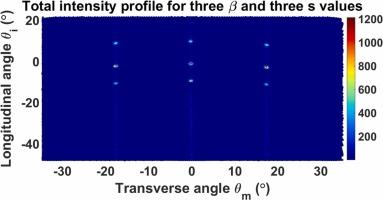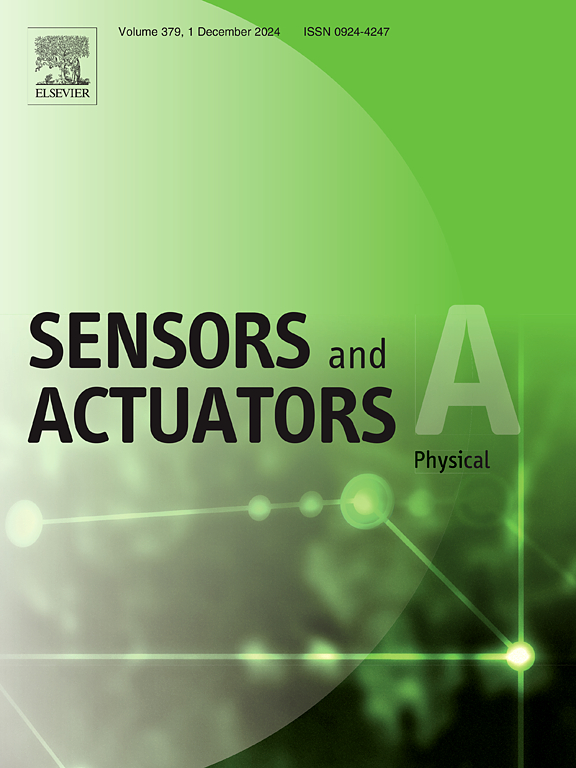利用相控阵 MEMS 可调光栅耦合器实现二维光束转向
IF 4.1
3区 工程技术
Q2 ENGINEERING, ELECTRICAL & ELECTRONIC
引用次数: 0
摘要
本文介绍了一种二维(2D)光束转向系统,该系统使用由一维(1D)微机电系统(MEMS)可调光栅耦合器组成的一维(1D)光学相控阵。调谐光学相控阵元件之间的增量相位差 β 可用于将光束转向一个方向(例如横向)。与此同时,对单个光栅耦合器进行微机电系统调谐可将光束转向垂直方向(纵向)。通过将 β 从 -70° 变为 70°,可在横向方向上实现 ∼35° 的光束转向。通过对 MEMS 可调光栅耦合器施加 1.6 伏的电位差,光束沿纵向方向的转向为 19°。该装置的光束宽度为 1.75° × 0.82°,其机械和光学设计孔径为 100 μm × 100 μm。当孔径增大到 1 mm × 0.2 mm 时,光束宽度进一步减小到 ∼ 0.15° × 0.5°。100 μm × 100 μm 的孔径支持高达 ∼ 50 kHz 的光束转向频率,与采用其他技术(如波长调谐(WT)和二维相控阵)的现有先进设备相当。这种微机电系统所需的最大电压仅为 1.6 伏左右,因此电路简单,功耗低。本文章由计算机程序翻译,如有差异,请以英文原文为准。

2D beam steering using phased array of MEMS tunable grating couplers
This paper describes a two-dimensional (2D) optical beam steering system using a one-dimensional (1D) optical phased array of 1D micro-electromechanical systems (MEMS) tunable grating couplers. Tuning the incremental phase difference β between the elements of an optical phased array is used to steer the beam in one direction (say, transverse). At the same time, the MEMS tuning of the individual grating couplers steers the beam in the perpendicular direction (longitudinal). A beam steering of ∼35° could be demonstrated along the transverse direction by varying β from −70° to 70°. The beam steering was ∼19° along the longitudinal direction by applying a potential difference of ∼ 1.6 volts to the MEMS tunable grating couplers. The beam width of the device with a mechanically and optically designed aperture of 100 μm × 100 μm is ∼ 1.75° × 0.82°. The beam width further reduces to ∼ 0.15° × 0.5° when the aperture increases to 1 mm × 0.2 mm. The 100 μm × 100 μm aperture supports a beam steering frequency of up to ∼ 50 kHz, comparable to the available state-of-the-art devices using other technologies like wavelength tuning (WT) and 2D phased arrays. The maximum voltage required by this MEMS is only around 1.6 volts, resulting in simple circuitry and low power consumption.
求助全文
通过发布文献求助,成功后即可免费获取论文全文。
去求助
来源期刊

Sensors and Actuators A-physical
工程技术-工程:电子与电气
CiteScore
8.10
自引率
6.50%
发文量
630
审稿时长
49 days
期刊介绍:
Sensors and Actuators A: Physical brings together multidisciplinary interests in one journal entirely devoted to disseminating information on all aspects of research and development of solid-state devices for transducing physical signals. Sensors and Actuators A: Physical regularly publishes original papers, letters to the Editors and from time to time invited review articles within the following device areas:
• Fundamentals and Physics, such as: classification of effects, physical effects, measurement theory, modelling of sensors, measurement standards, measurement errors, units and constants, time and frequency measurement. Modeling papers should bring new modeling techniques to the field and be supported by experimental results.
• Materials and their Processing, such as: piezoelectric materials, polymers, metal oxides, III-V and II-VI semiconductors, thick and thin films, optical glass fibres, amorphous, polycrystalline and monocrystalline silicon.
• Optoelectronic sensors, such as: photovoltaic diodes, photoconductors, photodiodes, phototransistors, positron-sensitive photodetectors, optoisolators, photodiode arrays, charge-coupled devices, light-emitting diodes, injection lasers and liquid-crystal displays.
• Mechanical sensors, such as: metallic, thin-film and semiconductor strain gauges, diffused silicon pressure sensors, silicon accelerometers, solid-state displacement transducers, piezo junction devices, piezoelectric field-effect transducers (PiFETs), tunnel-diode strain sensors, surface acoustic wave devices, silicon micromechanical switches, solid-state flow meters and electronic flow controllers.
Etc...
 求助内容:
求助内容: 应助结果提醒方式:
应助结果提醒方式:


